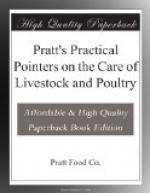[Illustration: WHITE WYANDOTTES]
Pratts Poultry Service Department is maintained to give expert information and advice on poultry topics. There is no charge for this service. Whenever you get puzzled, write Pratts experts. They will send you a prompt personal reply containing the information you desire. No charge, no obligation. Address such letters to Poultry Service Department, Pratt Food Co., Philadelphia.
[Illustration: S.C. WHITE LEGHORNS]
Breeds of Poultry
Regardless of breeding and appearance, a heavy layer is a good hen to own. And laying ability is not confined to any one breed or class of fowls. There are exceptional layers, dependable profit-payers, in practically every fair-sized flock, whether made up of standard-bred stock or mongrels.
As a general rule, however, standard-bred birds are best. By that term we mean those which have been bred to meet the typical breed and variety descriptions as appearing in the official Standard of Perfection which is published by the American Poultry Association. Such a flock is bound to be uniform in size, appearance and general characteristics, is easier to manage properly because of its uniformity, and its products, both eggs and table poultry, will also be uniform. Further the income from such a flock may be increased through the sale of eggs for hatching and of breeding stock at prices many times greater than those of table eggs and poultry.
No matter what breed you select, the most important matter, the very foundation of success, is the securing of individual birds which are strong, sturdy, vigorous and healthy. Only stock of high vitality can be depended upon to give continuously good results. It is time and money wasted to keep fowls which are weak, sickly or “run-down,” the result of improper breeding or management.
As a rule, it is best to select that breed which is most popular locally, because such popularity indicates that the breed in question thrives under local conditions and meets the requirements of the local markets. Further, one has greater opportunities of securing good birds and a larger market for hatching eggs and stock.
[Illustration: RHODE ISLAND REDS]
-------------------------------------------------------
---------- Clemson College, S.C.
We have been using Pratts
Baby Chick Food and are very well pleased
with it. I think
that it is the best baby chick mash on the market
today.
FRANK C. HARE, Prof. of Poultry Husbandry._ ------------------------------------------------------------
-----
Among the farmers whose markets demand white-shelled eggs, the S.C. White Leghorn is the most popular fowl. The Black Minorca is another favorite. It produces the largest white eggs.
[Illustration: TOLMAN TYPE HOUSE]
Where brown-shelled eggs are wanted, the Plymouth Rock, Wyandotte, Rhode Island Red and Orpington lead. And for the production of the largest table carcasses the Light Brahma, either pure or crossed with a more active breed, is a favorite. The live weights of adult birds of these breeds are as follows:




